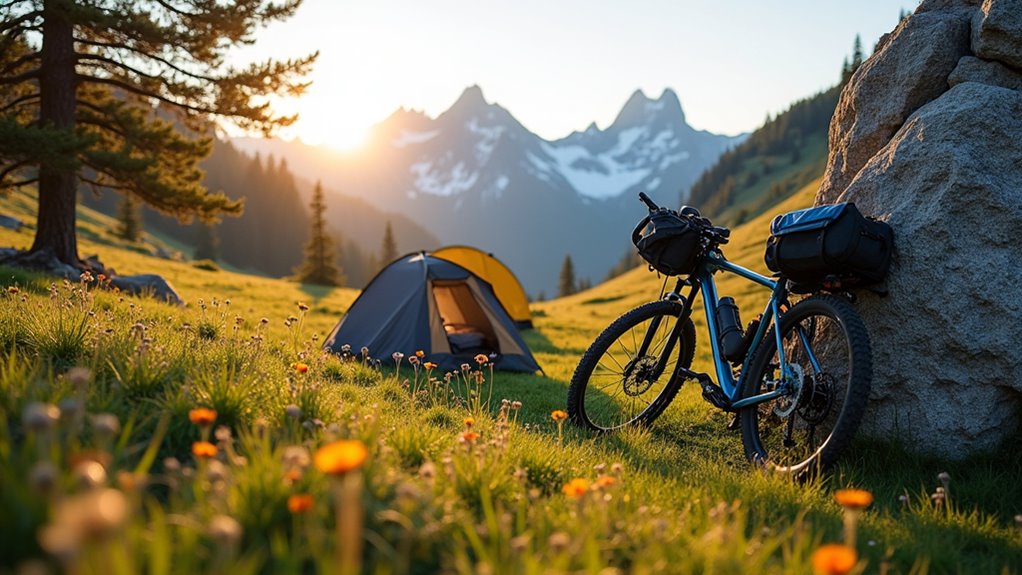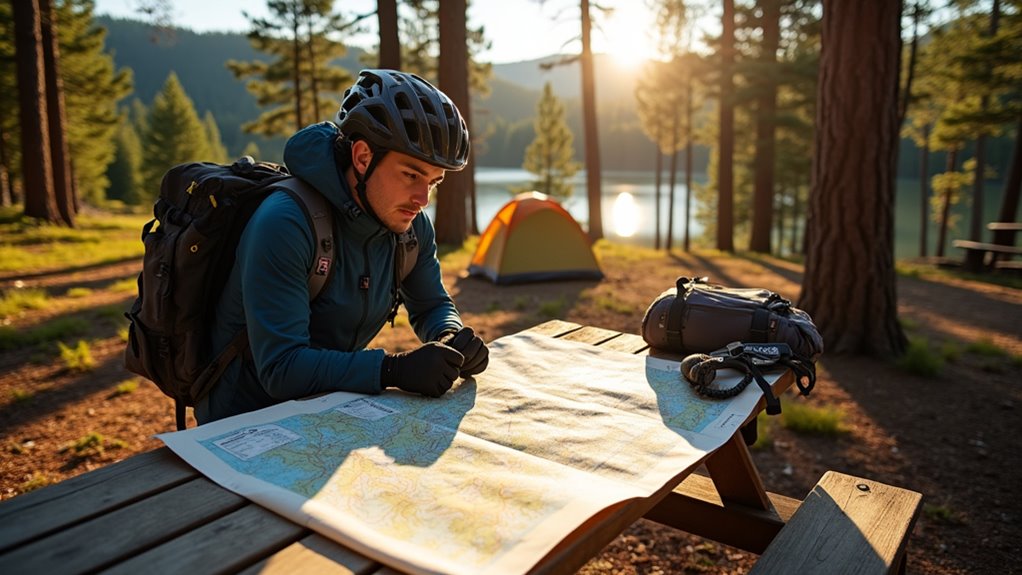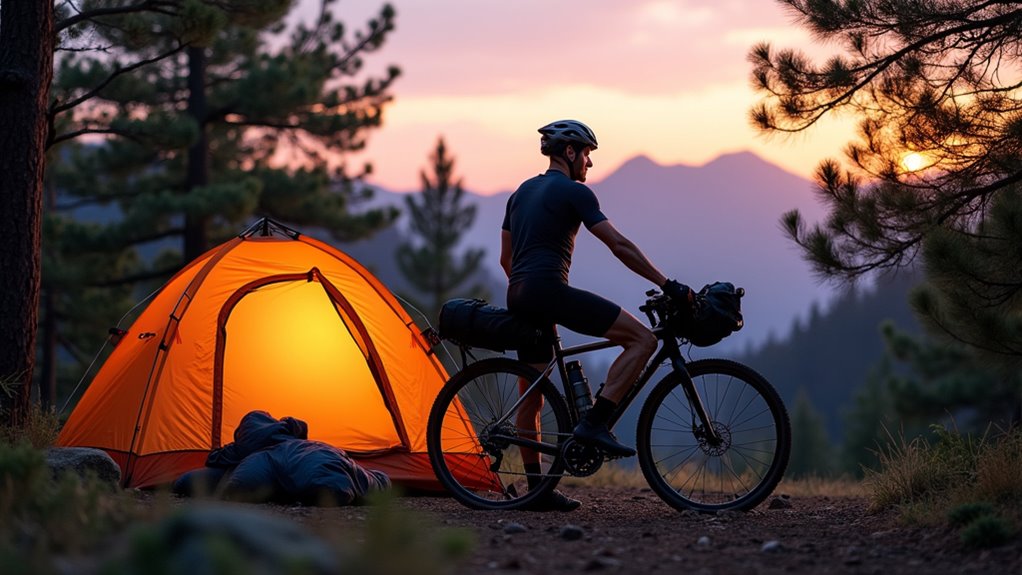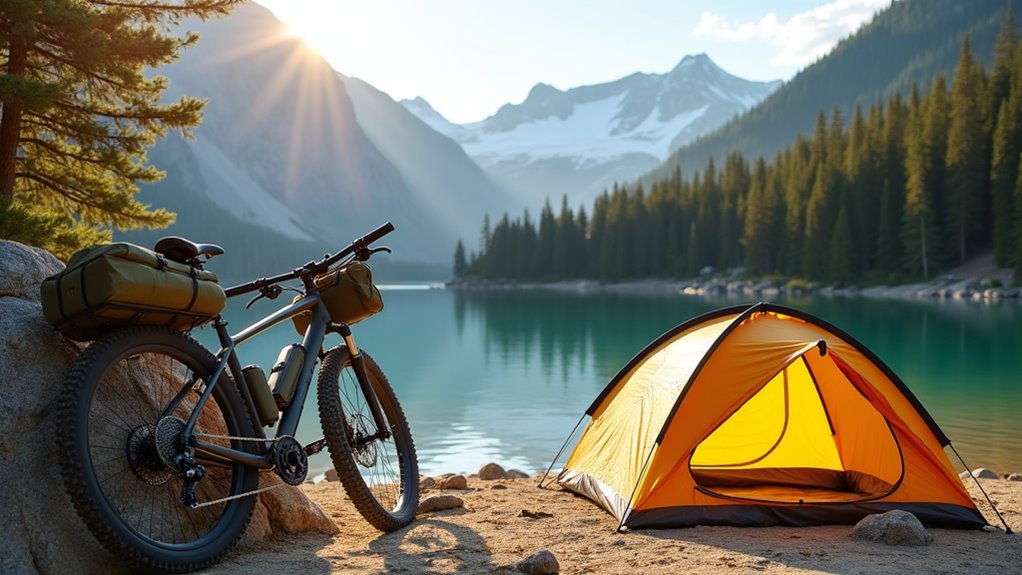Physical Address
304 North Cardinal St.
Dorchester Center, MA 02124
Physical Address
304 North Cardinal St.
Dorchester Center, MA 02124

Bicycle camping blends adventure and fitness into unforgettable journeys, but choosing the wrong gear could ruin your first multi-day expedition.
When Sarah packed her panniers for a three-day ride through Vermont’s Green Mountains, she discovered what thousands of outdoor enthusiasts already know—bicycle camping transforms ordinary fitness routines into extraordinary adventures. You’ll pedal through breathtaking landscapes while your legs grow stronger and your cardiovascular system thanks you for the workout. But there’s a vital difference between dreaming about bikepacking and actually succeeding on your first multi-day journey, and it starts with choosing the right equipment.

When you’re planning your first bikepacking trip, the gear you choose can make or break your adventure on two wheels. You’ll need a lightweight tent that packs small, sleeping bag rated for expected temperatures, and a compact sleeping pad for comfort.
Don’t forget a reliable bike repair kit with tire levers, patches, and a multi-tool.
Pack efficiently using frame bags, handlebar bags, and seat packs designed specifically for bikepacking. These distribute weight better than traditional panniers on rough terrain.
Your clothing should be moisture-wicking layers you can mix and match. A portable stove, lightweight cookware, and water purification tablets are essential for extended trips.
Start with overnight adventures to test your setup before committing to longer expeditions. Like RV camping, many secret tips for bikepacking success come from experienced adventurers who’ve learned through trial and error in the field.
While gear selection matters tremendously, your bicycle choice will ultimately determine whether you’re cruising comfortably through scenic backroads or struggling up every hill with an overloaded rig. You’ll want a bike that balances durability, comfort, and cargo capacity.
Touring bikes remain the gold standard—they’re built for heavy loads with sturdy steel frames and relaxed geometry.
Gravel bikes offer versatility for mixed terrain adventures, though they’re less ideal for extensive gear hauling.
Mountain bikes work brilliantly on rugged trails but sacrifice efficiency on pavement.
Consider your frame material carefully. Steel forgives rough roads and repairs easily in remote areas.
Your gearing should include a wide range—you’ll appreciate those low gears when climbing mountain passes fully loaded.
Don’t overlook mounting points for racks and bottles.
Before heading into challenging terrain, familiarize yourself with basic rules that mountain adventurers follow to ensure safe and successful multi-day trips.

Once you’ve selected your ideal bike, the real adventure begins with mapping out where you’ll actually ride and sleep. Start by researching dedicated bike routes like rail-trails or scenic byways that offer gentle grades and minimal traffic.
The true journey starts not with pedaling, but with carefully plotting your path and overnight stops along the way.
Apps like Warmshowers connect you with cycling-friendly hosts, while websites like Freecampsites.net reveal hidden gems beyond crowded RV parks.
Consider your daily mileage realistically – most touring cyclists cover 40-60 miles per day. Factor in grocery stops, water refills, and those inevitable photo breaks at stunning viewpoints.
State parks often welcome cyclists with hiker-biker sites at reduced rates. Don’t overlook fire stations or churches, which frequently allow overnight camping when asked politely.
Always have backup plans, because weather and mechanical issues happen when you’re miles from civilization.
For cyclists seeking a more comfortable base camp experience, caravan camping offers the perfect blend of outdoor adventure and convenient amenities while still maintaining that close connection to nature.
Since every ounce counts when you’re pedaling uphill with your entire life strapped to your bike, mastering the art of efficient packing can make or break your touring experience. Start with your heaviest items—sleeping bag, tent, and cooking gear—positioned low in rear panniers near your bike’s center of gravity. This creates stability and prevents that dreaded wobble that’ll have you white-knuckling every descent.
Distribute weight evenly between left and right sides, keeping your front-to-rear ratio around 60-40. Pack frequently used items like snacks, tools, and rain gear in easily accessible spots. Roll clothes tightly, stuff sleeping bags last, and use every nook—your water bottle cage can hold tools, and frame bags maximize space without affecting handling.
Smart packing transforms grueling slogs into enjoyable adventures. Just like hikers who carefully select their essential items for the perfect bag, cyclists need to prioritize what makes the cut for their panniers.

Before you load those panniers and hit the road, your body needs to become as dependable as your gear. Start training at least eight weeks before your trip, gradually building your endurance and saddle time. Begin with shorter rides and add 10-15 miles weekly until you’re comfortable riding your planned daily distances.
Your body must be as reliable as your bike – start training eight weeks early with gradual mileage increases.
Focus on leg strength with squats and lunges, but don’t neglect your core – it’s essential for maintaining proper posture during long hours in the saddle. Practice riding with loaded panniers to simulate real conditions and identify any discomfort early.
Include hill training and headwind sessions to prepare for challenging conditions. Most importantly, listen to your body and rest when needed.
If you’re expecting mothers planning a bicycle camping adventure, consider additional precautions and consult with your healthcare provider before embarking on extended cycling trips.
You’ll thank yourself when you’re cruising comfortably through beautiful landscapes instead of struggling through each mile.
While building physical strength prepares your body for the journey ahead, developing a solid safety plan protects you when things don’t go as expected. You’ll want to pack a thorough first-aid kit including bandages, antiseptic, pain relievers, and any personal medications.
Always inform someone about your route and expected return time. Carry emergency communication devices like a whistle, mirror, or satellite messenger for remote areas.
Weather can change rapidly, so monitor forecasts and pack appropriate gear. Keep your bike maintenance kit stocked with spare tubes, tire levers, multi-tool, and chain links. Practice basic repairs before hitting the trail.
Trust your instincts—if conditions feel unsafe, it’s better to postpone or alter your route. Your adventure should challenge you, not endanger you. Consider planning a vegan-friendly camping experience that aligns with your dietary preferences and values while exploring the outdoors.

Where should you point your handlebars for your first bikepacking adventure? Start with established rail-trails like the Great Allegheny Passage or Virginia’s New River Trail—they’re beginner-friendly with predictable terrain and regular resupply points.
For intermediate riders, consider the Colorado Trail’s bikeable sections or Utah’s White Rim Road. These offer stunning scenery without overwhelming technical challenges. You’ll find designated camping areas and water sources along most segments.
Advanced bikepackers shouldn’t miss the Arizona Trail or Oregon’s McKenzie River Trail. These routes demand solid skills but reward you with unforgettable landscapes.
Research each destination’s regulations beforehand—some require permits or restrict camping locations. Check seasonal conditions too; mountain routes often close during winter months.
Local bike shops near trailheads offer invaluable insider knowledge about current trail conditions and hidden gems. For those seeking the ultimate challenge, consider exploring areas near glacier climbing routes, which offer some of the most pristine and rugged terrain in the country.
You’ll join over 40 million Americans who’ve discovered the magic of combining pedal power with outdoor adventures. That’s roughly one in eight people who’ve traded four wheels for two and found freedom on trails nationwide. Your legs become your engine, your bike becomes your pack mule, and every hill conquered feels like a personal victory. Start planning your first bikepacking trip today—you’re just one ride away from discovering why this community’s growing so rapidly.